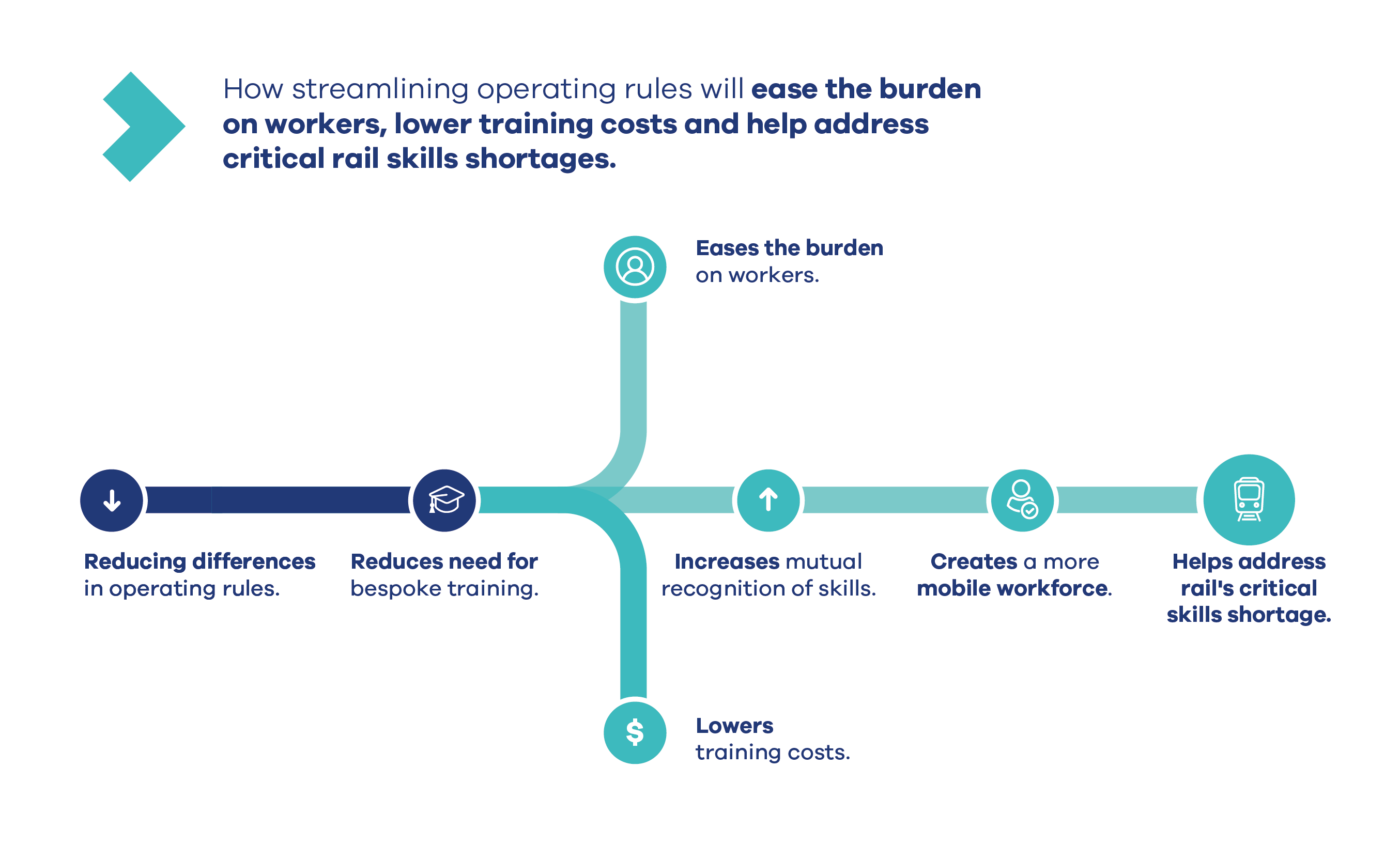Latest news
Australia’s infrastructure and transport ministers have agreed on a long-term plan for streamlining rolling stock approvals and a phased pathway for achieving it. This will make it easier for rail operators to introduce new, safer, and more efficient trains onto our networks.
The National Pathway, developed by the NTC and Transport for New South Wales, initially focuses on aligning the approval processes for freight trains across a small group of core rail infrastructure managers. Once this is achieved it will be adapted and delivered nationally for all rolling stock.
To get involved in the NTC’s program to streamline the rolling stock approvals process contact the team at rollingstock@ntc.gov.au.
Streamlining rules, processes and training
Different infrastructure, rules and ways of working across networks have led to unique training and assessment procedures, as well as varying approval processes for introducing new trains.
This means workers often need to be retrained and reassessed to work on specific networks, while freight operators must have their rolling stock re-tested and approved for every network they operate in.
Through the National Rail Action Plan (NRAP), we’re bringing governments, industry, regulators and unions together to develop a common set of operating rules and practices recognised across all networks. We’re also simplifying and streamlining the rolling stock approval process to make it faster and more consistent.
More harmonised rules and processes will:
- reduce the burden on workers
- improve safety and consistency
- lower costs and time lost to retraining
- make it easier for workers to move across networks, supporting a more flexible and skilled workforce
- encourage investment in new rolling stock and technologies
A simpler rolling stock approval process
Australia’s governments want to move more freight by rail — reducing road congestion, improving safety and helping the country meet emissions targets.
To support this, the NTC is working with governments and industry to:
- clarify roles and responsibilities in relation to the rolling stock approval process
- develop and pilot a single national application process
- identify ways to harmonise rolling stock testing requirements and locations
- develop a mandatory process standard for rolling stock approvals to lock in interoperability
In May 2025, we released a consultation paper analysing current rolling stock approval processes, and sought feedback on ways to clarify the roles and responsibilities of different parties involved.
A Summary of Feedback to the consultation paper which includes an overview of the National Pathway on streamlining rolling stock approvals can be found here.
ONRSR will develop a guideline on rolling stock approval processes and consult with industry in early 2026. We will continue to work with them on this important initiative.
In August 2025, Infrastructure and Transport Ministers endorsed a National Pathway to streamline rolling stock approvals. This Pathway brings together existing reform initiatives across jurisdictions and stakeholders, building on the NTC’s work and providing opportunities for greater coordination.
The Pathway sets a cooperative and staged approach towards a long-term vision of a common national approval process that reduces costs and regulatory burden for industry.
It consolidates all existing NTC initiatives - such as safety assurance guidance, the development and piloting of a single application form and harmonising testing arrangements. As well as jurisdictional projects, including harmonising common interface standards, the NSW network acceptance process, and the Rail Industry Safety and Standards Board (RISSB) National Rolling Stock Register (NRSR) and registration system.
A simpler, nationally consistent approach to approvals will save the rail industry tens of millions of dollars each year and encourage investment in innovative, lower-emission rolling stock and technology.
National Network Rules project
Today Across Australia, rail workers may need to understand up to 12 different rule books and maintain competencies for every network they work on.
While many of these competencies overlap, they are not mutually recognised — so workers often need to retrain in skills they already have when moving between jobs or networks. This includes learning different rules, terminology, hand signals and signage.
Through the National Rail Action Plan (NRAP), the NTC is working with the Australasian Railway Association (ARA), Rail Industry Safety and Standards Board (RISSB) and industry to develop a common set of operating rules and practices that reduce the need for bespoke training.
The first four rules and five supporting actions identified for harmonisation relate to:
- walking in the danger zone
- communications
- planning works in the rail corridor
- reporting and responding to conditions affecting the network.
Implementation options for these harmonised rules are being considered as part of the Consultation Regulatory Impact Statement (C-RIS) for upcoming Rail Safety National Law (RSNL) reforms, which will be released for public consultation in early 2026.
To support this work, we’ve also identified rail’s top 10 operations and maintenance roles across Australia’s 18 rail networks and grouped together their most common titles. You can find a copy of the report here.
Comparing roles, responsibilities and rules across all networks is a complex task. The NTC is exploring how artificial intelligence tools can help accelerate this work.
Harmonising training and onboarding
We’re also working with industry, the education sector and Industry Skills Australia (ISA) to develop entry level training that is recognised by all networks.
This will:
- reduce training costs
- make it easier for workers to move across network
- help skilled workers from different backgrounds find a job in rail.
How to participate
If you'd like to find out more about how we are helping to align digital train control technologies send us an email or subscribe to our monthly newsletter here.
To make a formal submission in response to our discussion papers you can find out more here.
- Log in to post comments

